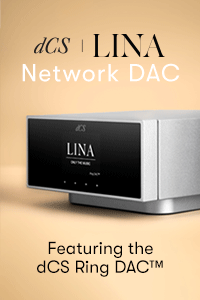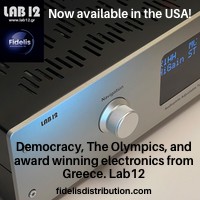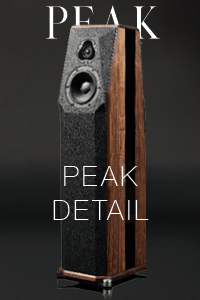 Just in case you are wondering, PSA stands for Pyramid Stereo Amplifier. If you were like me and were drooling over those cool pyramid-shaped monoblocks from Nagra a couple of years ago, this is the next step in their product line. The PSA delivers 100 watts per channel, as opposed to the 200 watt per channel PMA monoblock amplifiers and is priced at $6595.
Just in case you are wondering, PSA stands for Pyramid Stereo Amplifier. If you were like me and were drooling over those cool pyramid-shaped monoblocks from Nagra a couple of years ago, this is the next step in their product line. The PSA delivers 100 watts per channel, as opposed to the 200 watt per channel PMA monoblock amplifiers and is priced at $6595.
If you want an amplifier that not only sounds great but is a show stopper, along the lines of a Ferrari Enzo, the PSA is the ticket. I guarantee anyone that sees this in your home and has even a passing interest in aesthetics will be intrigued by this amplifier that can easily pose as a piece of modern artwork. Everyone that saw it in my studio was fascinated by its stunning good looks.
I first saw the PSA at the Rocky Mountain Audio Fest in October, where the head of U.S. Sales for Nagra, John Quick was showing it off with Nagra’s new CD player and a new pair of Verity Audio (another favorite of mine) Rienzi speakers in a huge room. The PSA had no problem driving these speakers as loud as I needed to hear them. I made it a point to drag each one of the TONE staffers in attendance down to the Nagra/Verity room to hear this system!
As someone who grew up with giant amplifiers from ARC, Krell and a few others, I definitely went through massive amplifier phase of my audiophile life. Granted, I worship great sound above all else, but when I can get great sound in a beautiful package it’s a huge bonus.
Setup
The PSA is not a terribly large pyramid, with a base of 15” x 15” and about 10” high. It weighs 35 pounds, so you can actually think of it as your personal pyramid. All kidding aside, this is a serious amplifier and though it possesses a switching power supply, it is a traditional audio amplifier, not Class D.
It will run comfortably on a 15 amp circuit, as it only draws 500 watts at full output. It features a pair of WBT binding posts on the rear panel along with a pair of XLR input connectors. Nagra is kind enough to supply a pair of RCA adaptors, so if your system does not have a balanced input you are covered. Please note, in the interest of keeping a compact rear panel, there is only the single pair of balanced inputs.
As our vintage columnist Kurt Doslu likes to say, “Don’t play catch with this one!” However, I liked the shape so much; I actually put the PSA up on a pedestal. I had an old concrete pedestal that looked like a column from the porch of one of the houses in Gone With the Wind, but this was not the optimum setup for the ultimate sound quality.
I had great luck using the PSA on a large Symposium Ultra platform that I often use as an amplifier stand. Once connected to my Aesthetix Callisto Signature, we were ready to begin listening. My test unit had already had some hours put on it at the RMAF, so I can not accurately tell you how long one takes to break in; this one sounded great after two days of continuous play. The rest of my system was rounded out with the Penaudio Serenades, Wadia 581 and the AVID Volvere turntable with a Sumiko Celebration cartridge installed. I used a pair of Cardas Golden Reference interconnects with XLR termination and left the PSA balanced from the Callisto with excellent results for the majority of the review period. I tried it both ways, but with the Callisto, could not hear a difference between the two.
Due to the close proximity of the speaker binding posts, I would suggest having the ends that go to your amplifier terminate with banana plugs. I did manage to get some spade lugs in the terminals, but if you are looking for the most aesthetically pleasing setup, go for the bananas, it looks much tidier.
Lurking underneath the cool pyramid top panel is a set of jumpers to adjust the input sensitivity for the PSA. You have a choice of 1V or 2V sensitivity. My Callisto has a lot of gain, so I chose the 2V setting and that was perfect, keeping maximum volume right around the 12:00 position on the volume controls, just how I like it.
 Does the sound live up to the fashion forward design?
Does the sound live up to the fashion forward design?
Definitely. I was very impressed with what I had heard at the RMAF, so I figured if they could get sound that good at a show, it would be considerably better in my more reasonably sized room and I have not been disappointed. If I were to sum up the PSA in only one word, I would call it precise. Ah, but it comes from Switzerland, so why would you expect anything else but precision from the Swiss?
To expand this definition a bit more closely, what I noticed immediately about the PSA is that it has a very dynamic sound, but never out of control. The highs are extended without being exaggerated or grainy. The bass has weight and texture, but you will never mistake this one for a Krell amplifier, either. It’s just right.
If you are an audiophile that wants an amplifier that is very tonally accurate and has the punch of a solid state amplifier over tubes, this is one to put on your short list. (especially if you are a person that is design conscious)
Some people will make fun of this amplifier for having a tiny blue LED for power output and a tiny red LED to indicate clipping in the lower right corner of the front panel. I say it’s a lot of fun and a very useful device. But fear not, there is a switch beneath the amplifier under a small cap to turn the blue level LED off of you prefer. If you had to judge clipping by ear, you would be melting tweeters by the bucketload, because on the rare occasion that I did see that red LED light up, I was listening to music WAY TOO LOUD and it sure didn’t sound like the amp was going into clipping at all. I also found the gently pulsing blue light coming from the base of the pyramid to be very soothing.
As I was in the middle of the Charlie Hunter interview while working on this review, I listened to the PSA with a lot of jazz in addition to the whole Charlie Hunter catalog. The PSA always did a fantastic job with revealing the most minute details and the trailing edges of percussion instruments. Cymbals had great air as well as attack on Charlie’s first album Bing, Bing, Bing! Not to worry though, when things got a little bit beefier on his current release, Copperopolis (especially the first cut) this amplifier did not flatten out. Taking this groove to its ultimate conclusion, I went for broke, put Joe Satriani’s The Extremist (back in the day, Charlie used to take guitar lessons from Joe…) in the player and really cranked it up.
Even with very dense rock guitar music, the PSA held its poise and did an outstanding job of preserving that precious space between the notes. Exceptional quality from a solid state amplifier indeed. Then I sharpened all my razor blades. Just kidding.
Very neutral… just like Switzerland
The really handy thing about a power amplifier that has this neutral of a sound is that you can do your system tuning elsewhere. Because my Callisto is a bit on the slightly warm and slightly wet side of the presentation, for me it was the perfect match to the PSA. I did try it with a number of different preamplifiers, but I kept coming back to the Callisto with this one. I haven’t had a chance to sample the excellent Nagra PL-L or PL-P linestages yet (which are both tube units), but again I really enjoyed what I heard at the RMAF, so watch for a future review.
Some of you may have the burning question as to whether 100 watts per channel is enough. Always a tough call, but I think that in most cases it should be more than adequate. It depends on the side of the room and what speakers you are pairing it with. The 87db Rienzi speakers were playing in a room that was 22’ x 26’ (with an 11’ drop ceiling) and the sound was very big and involving, so I would think in a moderate sized room with speakers in the 87-90db range, you should have more than enough power to spare.
My main listening room is 16’ x 24’ and I never ran out of power with the PSA with my 87db Penaudio Serenades, or the 84 db ACI Sapphire XL’s. The only speakers that did give it some grief were my Apogees, but they give almost every amplifier grief due to their 82db sensitivity and 3 ohm load.
 A very interesting alternative to the box
A very interesting alternative to the box
In my book, the Nagra PSA’s performance justifies its price. Add their legendary build quality and outstanding mechanical aesthetics and you have a pretty interesting little amplifier. If your listening requirements demand good sound, high quality and intriguing looks, this is the amplifier for you!
Nagra PSA amplifier
MSRP: $6595
Peripherals
| Preamplifiers | Conrad Johnson ACT2/series 2 Aesthetix Callisto Signature |
| Speakers | Tetra 506 Custom Penaudio Serenade DeVore Gibbon Super 8 |
| Analog Sounce | Avid Volvere w/SME V arm and Sumiko Celebration cartridge BAT VK-P10SE phono stage |
| Digital Source | Wadia 581 |
| Interconnects | Cardas Neutral Reference |
| Speaker Cable | Cardas Neutral Reference |
| Power Cords | Running Springs Mongoose |
| Power Conditioning | Running Springs Jaco |
| Vibration control | Finite Elemente Pagode Signature Rack with Cerepucs and Cereballs Symposium Ultra Platform and Rollerblock Jr.s |














